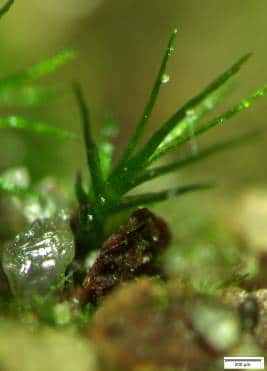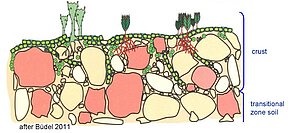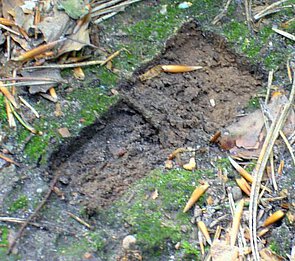Biodiversity and functional role of biological soil crusts
Biological soil crusts are a complex community of photosynthetically active green algae, cyanobacteria, mosses and lichens, heterotrophic fungi, protozoa and bacteria that cover the uppermost millimetres of the soil.
The community of organisms and their excretory products form a micro-ecosystem whose ecological function is particularly important in pioneer colonisation of open soils (e.g. nitrogen fixation by cyanobacteria, primary production, water retention, stabilisation of the topsoil or provision of plant-available nutrients).
Despite their important ecological function, soil crusts are mainly studied only in arid and semi-arid habitats. Therefore, this project aims to elucidate the species composition of temperate crusts and to investigate a possible correlation with land use intensity and soil parameters.
The determination of biodiversity within the soil crust will contribute to the identification of relationships among organisms and their responses to external factors, such as land use intensity.
The functional role of soil crusts in the biogeochemical cycles of C and N will be investigated using mass spectrometric fingerprinting (Py-FIMS, pyrolysis field ionisation mass spectrometry) and XANES (X-ray absorption near edge structure). Various C- and N-containing component classes of crusts and adjacent soil will be characterised and quantified, so that an influence of land use intensity on molecules or component classes can then be statistically determined.
P-fraction analyses of the crust and the adjacent soil will provide information on the ecological function of the soil crust as a mobiliser for mineral P-components of the soil.
1.With increasing land use intensity, the abundance of nitrogen-fixing cyanobacteria decreases and causes a shift in the community of partner organisms (ammonium-oxidising bacteria and archaea).
2. Intensified land use reduces the biochemical diversity of soil organic matter molecules while simultaneously enriching stable, N-containing molecules.
3. Mineral P fractions are transformed into organic fractions by the biological soil crust. An increase in land use intensity increases organic P fractions in the crust.
- Cultivation of photosynthetically active organisms
- Light microscopy
- PCR and 454 sequencing
- Py-FIMS (Pyrolyse Feldionisation Massenspektrometrie)
- C-, N-, P – XANES (X-ray Absorption Near Edge Structure)
- P fractionation
- 31P-NMR (nuclear magnetic resonance)
















